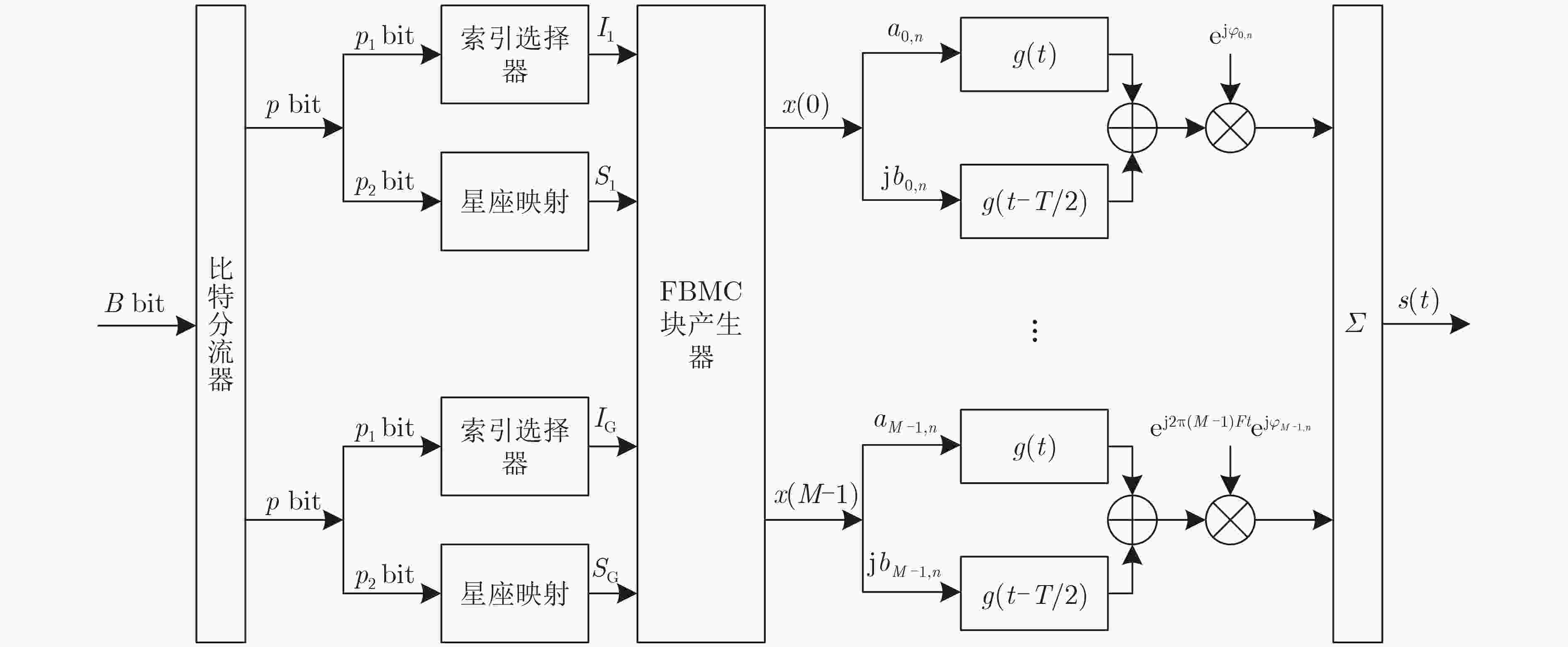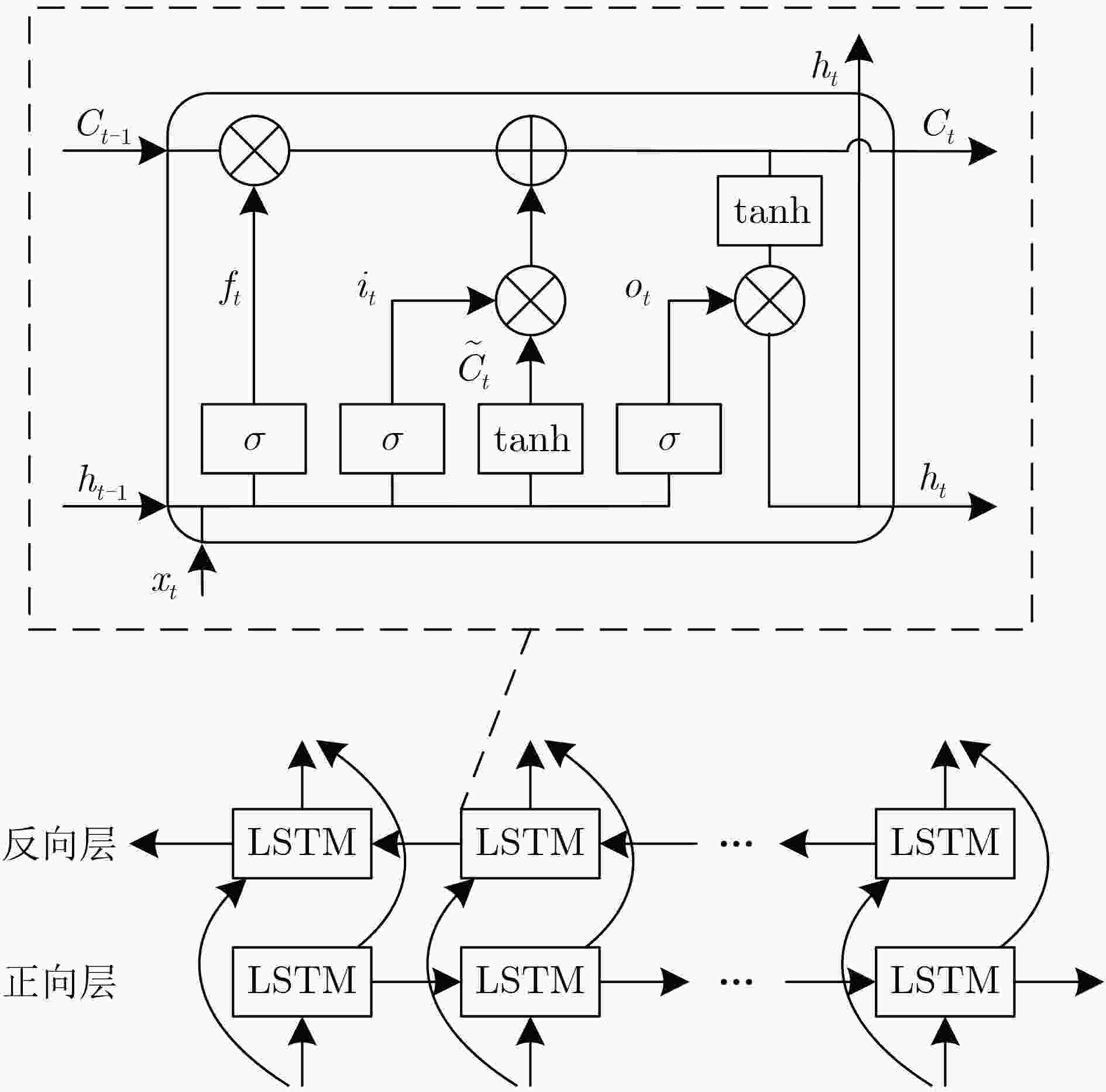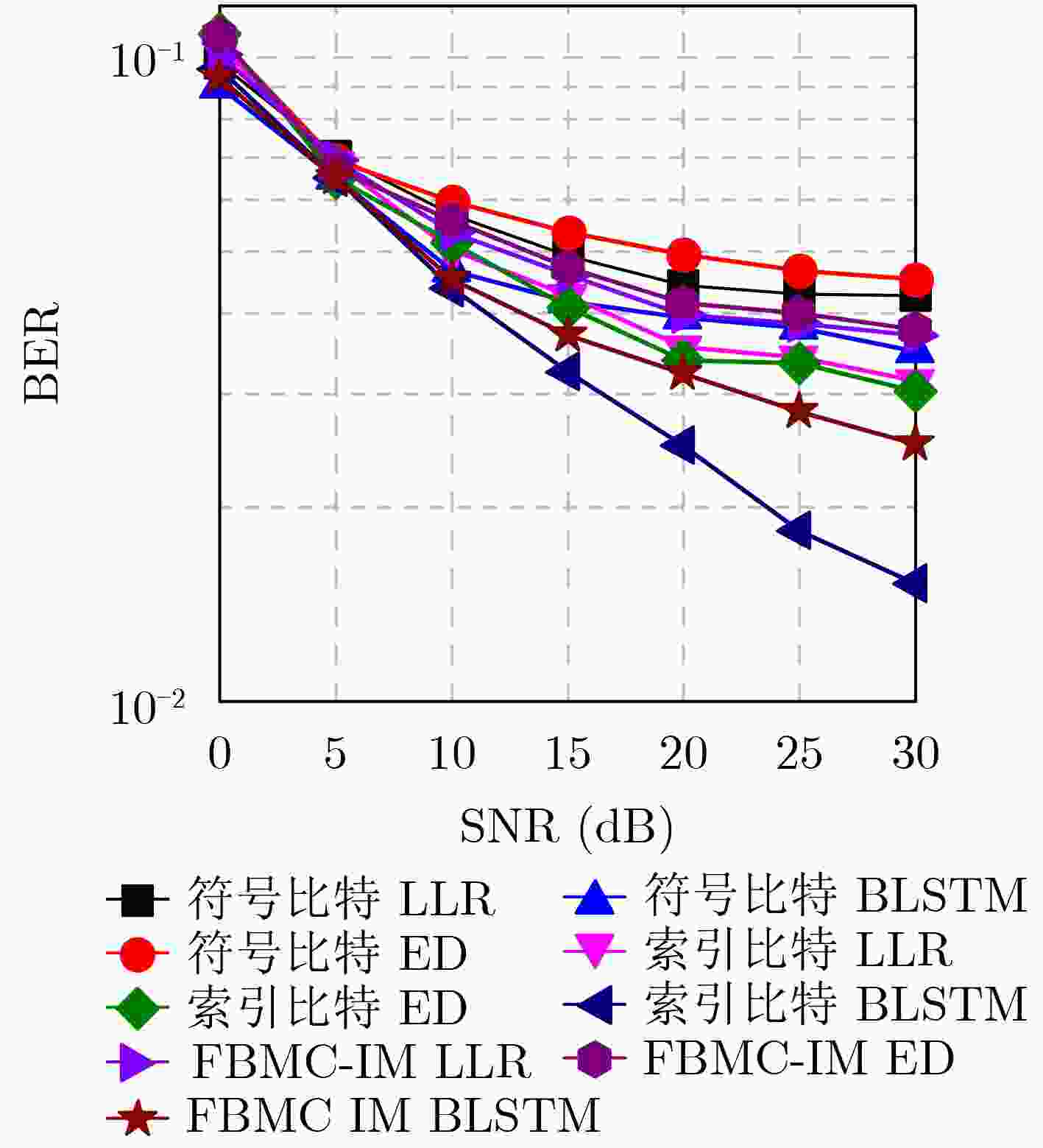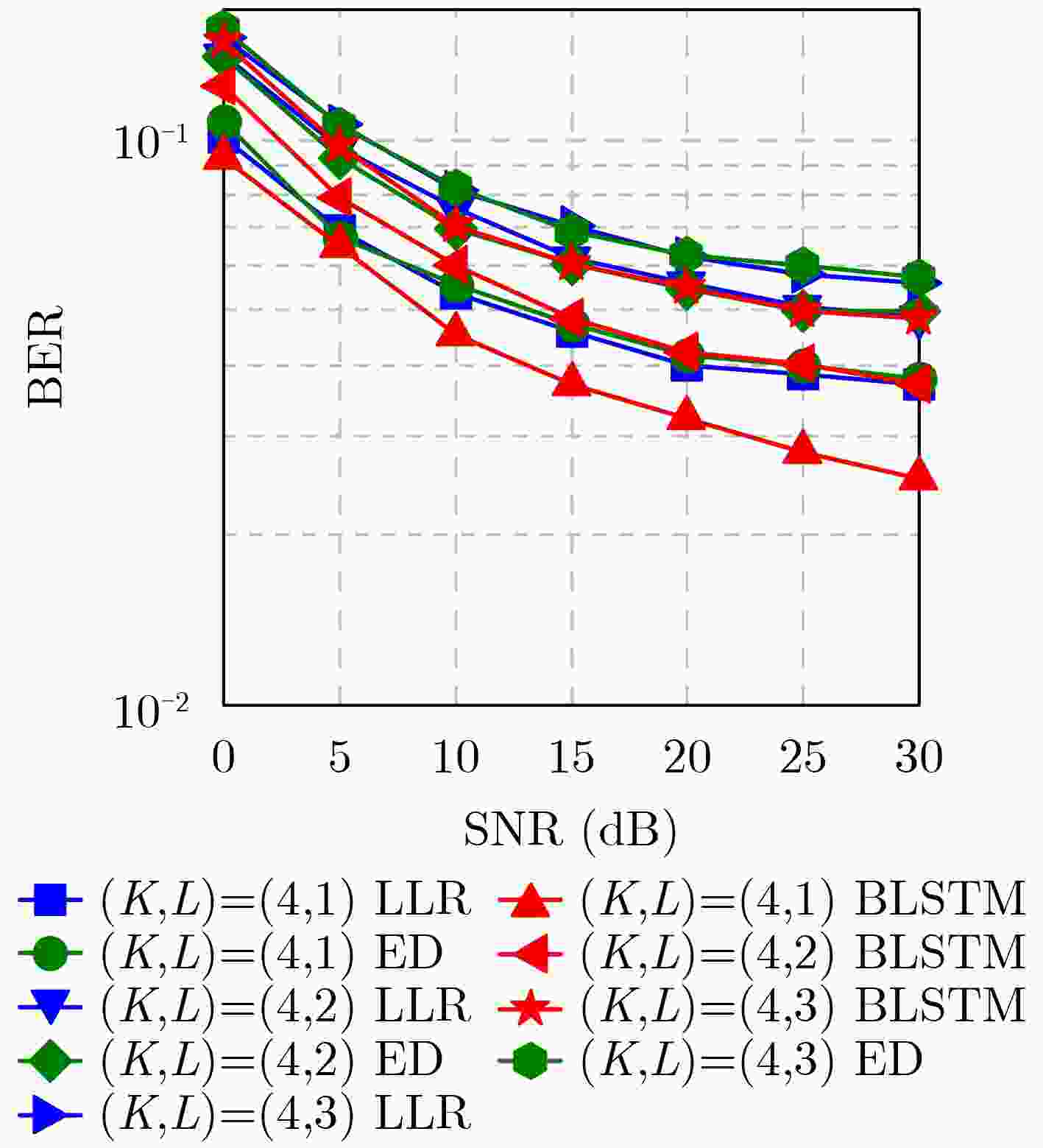Index Detection for Underwater Acoustic Multi-carrier Communication Based on Deep Bidirectional Long Short-term Memory Network
-
摘要: 索引调制滤波器组多载波(FBMC-IM)水声通信系统在进行信号检测时,需要先根据均衡后子载波上承载的恢复数据判断出活跃子载波的位置。针对传统检测方法估计索引信息时计算复杂度高且准确度较低的问题,该文结合双向长短时记忆网络(BLSTM)对时序信号进行特征提取的优势,将深度学习理论引入水声信号处理的概念,提出一种基于多层BLSTM的水声通信信号索引检测方法。该方法将传统索引检测问题转化为数据驱动的多元分类问题,在提高估计性能的同时降低了计算复杂度。基于湖试测得的水声信道数据仿真验证了该方法的优越性和鲁棒性,可以作为索引调制机制下的一种通用检测手段。Abstract: When the Index Modulated Filter Bank MultiCarrier (FBMC-IM) underwater acoustic communication system carries out signal detection, the first step is to determine the index of the active subcarriers according to the recovered data after equalization. In this paper, the advantage of Bidirectional Long Short-Term Memory (BLSTM) network for feature extraction of chronological signals is combined, the deep learning theory is introduced into the concept of underwater acoustic signal processing, and an index detection method based on deep BLSTM is proposed. The improved algorithm can increase the estimation accuracy by transforming the index detection into a data-driven multivariate classification. Compared with the traditional methods, the proposed algorithm has lower computational complexity but better bit error ratio performance. The superiority and robustness of the proposed method are verified by the simulation based on lake trial channel data, which can be considered as a general detection method under index modulation mechanism.
-
表 1
$ (K,L) = (4,2) $ 索引调制映射表组合序号 $ {p_1} $ $ {I_g} $ ${{\boldsymbol{x}}_g}$ one-hot标签 $ {C_1} $ 00 $ \{ 1,2\} $ ${[{s_g}(1),{s_g}(2),0,0]^{\rm{T}}}$ [1,0,0,0] $ {C_2} $ 01 $ \{ 1,3\} $ ${[{s_g}(1),0,{s_g}(2),0]^{\rm{T}}}$ [0,1,0,0] $ {C_3} $ 10 $ \{ 1,4\} $ ${[{s_g}(1),0,0,{s_g}(2)]^{\rm{T}}}$ [0,0,1,0] $ {C_4} $ 11 $ \{ 2,3\} $ ${[0,{s_g}(1),{s_g}(2),0]^{\rm{T}}}$ [0,0,0,1] $ {C_5} $ – – ${[0,{s_g}(1),0,{s_g}(2)]^{\rm{T}}}$ – $ {C_6} $ – – ${[0,0,{s_g}(1),{s_g}(2)]^{\rm{T}}}$ – 表 2 索引检测算法复杂度对比
算法名称 复杂度 ML检测 $ O({2^{{p_1}}}{Q^L}) $ ED检测 $ O(K) $ LLR检测 $ O(KQ) $ BLSTM检测 $ O({2^{{p_1}}}) $ 表 3 各信噪比下活跃子载波位置检测误索引率(IER)
载波状态与检测方法 0 dB 5 dB 10 dB 15 dB 20 dB 25 dB 30 dB $ (K,L) = (4,1) $, ED 0.1598 0.0930 0.0727 0.0590 0.0500 0.0457 0.0445 $ (K,L) = (4,1) $, LLR 0.1492 0.1016 0.0770 0.0609 0.0520 0.0480 0.0445 $ (K,L) = (4,1) $, BLSTM 0.1579 0.1030 0.0754 0.0571 0.0422 0.0330 0.0304 $ (K,L) = (4,2) $, ED 0.2445 0.1602 0.1125 0.0949 0.0887 0.0785 0.0742 $ (K,L) = (4,2) $, LLR 0.2410 0.1629 0.1219 0.1004 0.0867 0.0809 0.0742 $ (K,L) = (4,2) $, BLSTM 0.2209 0.1380 0.0988 0.0780 0.0631 0.0545 0.0493 $ (K,L) = (4,3) $, ED 0.2934 0.1887 0.1473 0.1219 0.1086 0.1000 0.0965 $ (K,L) = (4,3) $, LLR 0.2871 0.1984 0.1465 0.1207 0.1051 0.0957 0.0949 $ (K,L) = (4,3) $, BLSTM 0.2928 0.1879 0.1290 0.1046 0.0919 0.0809 0.0770 表 4
$ (K,L) = (4,1) $ 时不同$ \alpha $ 值的EGF滤波器组系统误索引率(IER)载波状态与检测方法 0 dB 5 dB 10 dB 15 dB 20 dB 25 dB 30 dB $ \alpha = 1/2 $, ED 0.1810 0.1332 0.1086 0.0941 0.0906 0.0879 0.0871 $ \alpha = 1/2 $, LLR 0.1781 0.1293 0.1129 0.0996 0.0910 0.0859 0.0848 $ \alpha = 1/2 $, BLSTM 0.2047 0.1458 0.1288 0.1153 0.1094 0.1009 0.0898 $ \alpha = 1 $, ED 0.1727 0.1098 0.0891 0.0730 0.0665 0.0549 0.0535 $ \alpha = 1 $, LLR 0.1688 0.1195 0.0848 0.0721 0.0566 0.0555 0.0531 $ \alpha = 1 $, BLSTM 0.1837 0.1231 0.0915 0.0740 0.0601 0.0539 0.0467 $ \alpha = 2 $, ED 0.1637 0.1102 0.0797 0.0668 0.0633 0.0543 0.0520 $ \alpha = 2 $, LLR 0.1590 0.1043 0.0840 0.0703 0.0586 0.0543 0.0527 $ \alpha = 2 $, BLSTM 0.1684 0.1150 0.0898 0.0703 0.0539 0.0467 0.0406 -
[1] LI Jianghui. Advanced OFDM receivers for underwater acoustic communications[D]. [Ph. D. dissertation], University of York, 2016. [2] HAN Jing, ZHANG Lingling, ZHANG Qunfei, et al. Low-complexity equalization of orthogonal signal-division multiplexing in doubly-selective channels[J]. IEEE Transactions on Signal Processing, 2019, 67(4): 915–929. doi: 10.1109/TSP.2018.2887191 [3] AMINI P, CHEN Rongrong, and FARHANG-BOROUJENY B. Filterbank multicarrier communications for underwater acoustic channels[J]. IEEE Journal of Oceanic Engineering, 2015, 40(1): 115–130. doi: 10.1109/JOE.2013.2291139 [4] 王彪, 方涛, 戴跃伟. 时间反转滤波器组多载波水声通信方法[J]. 声学学报, 2020, 45(1): 38–44. doi: 10.15949/j.cnki.0371-0025.2020.01.004WANG Biao, FANG Tao, and DAI Yuewei. Method of time reversal filter bank multicarrier underwater acoustic communication[J]. Acta Acustica, 2020, 45(1): 38–44. doi: 10.15949/j.cnki.0371-0025.2020.01.004 [5] BAŞAR E, AYGÖLÜ Ü, PANAYIRCI E, et al. Orthogonal frequency division multiplexing with index modulation[J]. IEEE Transactions on Signal Processing, 2013, 61(22): 5536–5549. doi: 10.1109/TSP.2013.2279771 [6] WEN Miaowen, CHENG Xiang, YANG Liuqing, et al. Index modulated OFDM for underwater acoustic communications[J]. IEEE Communications Magazine, 2016, 54(5): 132–137. doi: 10.1109/MCOM.2016.7470947 [7] ABU-ALHIGA R and HAAS H. Subcarrier-index modulation OFDM[C]. The 2009 IEEE 20th International Symposium on Personal, Indoor and Mobile Radio Communications, Tokyo, Japan, 2009: 177–181. [8] ZHANG Jian, ZHAO Minjian, ZHONG Jie, et al. Optimised index modulation for filter bank multicarrier system[J]. IET Communications, 2017, 11(4): 459–467. doi: 10.1049/iet-com.2016.0564 [9] 郭立民, 寇韵涵, 陈涛, 等. 基于栈式稀疏自编码器的低信噪比下低截获概率雷达信号调制类型识别[J]. 电子与信息学报, 2018, 40(4): 875–881. doi: 10.11999/JEIT170588GUO Limin, KOU Yunhan, CHEN Tao, et al. Low probability of intercept radar signal recognition based on stacked sparse auto-encoder[J]. Journal of Electronics &Information Technology, 2018, 40(4): 875–881. doi: 10.11999/JEIT170588 [10] YE Hao, LIANG Le, LI G Y, et al. Deep learning-based end-to-end wireless communication systems with conditional GANs as unknown channels[J]. IEEE Transactions on Wireless Communications, 2020, 19(5): 3133–3143. doi: 10.1109/TWC.2020.2970707 [11] ZHU Yunan, WANG Biao, ZHANG Youwen, et al. Convolutional neural network based filter bank multicarrier system for underwater acoustic communications[J]. Applied Acoustics, 2021, 177: 107920. doi: 10.1016/j.apacoust.2021.107920 [12] GAO Xuanxuan, JIN Shi, WEN Chaokai, et al. ComNet: Combination of deep learning and expert knowledge in OFDM receivers[J]. IEEE Communications Letters, 2018, 22(12): 2627–2630. doi: 10.1109/LCOMM.2018.2877965 [13] 陈友淦, 许肖梅. 人工智能技术在水声通信中的研究进展[J]. 哈尔滨工程大学学报, 2020, 41(10): 1536–1544. doi: 10.11990/jheu.202007110CHEN Yougan and XU Xiaomei. Research progress in artificial intelligence technology for underwater acoustic communications[J]. Journal of Harbin Engineering University, 2020, 41(10): 1536–1544. doi: 10.11990/jheu.202007110 -






 下载:
下载:









 下载:
下载:
